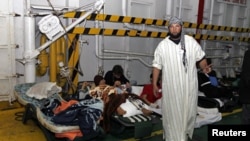The United States is pursuing a three-track policy with regards to Libya: first, delivering desperately needed humanitarian aid; second, pressuring and isolating the Muammar Gadhafi regime through sanctions and other measures; and third supporting efforts by Libyans to achieve their aspirations through political changes.
The U.S. Agency for International Development, or USAID, is leading American humanitarian efforts in Libya. According to Mark Ward, USAID Deputy Assistant Administrator for Democracy, Conflict, and Humanitarian Assistance, the humanitarian situation is quite dire in Libyan cities further to the west, where pro-Gadhafi forces have cut off or are bombarding cities such as Misrata.
To date, the United States has pledged almost $47 million dollars in humanitarian assistance to Libya. Twenty-seven million is for work along the principal borders of Libya, with Egypt and with Tunisia, to cope with the migrants and the Libyans who are coming out of the country. The bulk of the funding is going for evacuation flights so that people from third countries, most of them migrant workers, can go home.
The balance of the funding is for the humanitarian needs inside Libya. Money has been allocated for the prepositioning of food should it become necessary and will be provided through the World Food Program. So far, the World Food Program has prepositioned more than eleven-thousand tons of food in and around Libya.
USAID is also providing for important medical support. The medical supply situation in the east is sufficient, however, there is a shortage of medical personnel because many of the doctors and nurses in Libya were from other countries and have largely fled. With U.S. funding, our non-governmental organization, or NGO, partners are bringing in doctors and nurses to staff medical facilities and the World Health Organization has set up a medical training center focused on advanced life support and mass casualty management.
USAID is also delivering emergency health kits to have them ready to move into conflict areas when they become accessible for humanitarian organizations. This is exactly what USAID did in Ajdabiya after opposition forces regained control. Through a partner NGO, USAID was able to quickly send in medical supplies, doctors and nurses to the hospital there, and to a health clinic nearby where there were thousands of displaced persons who had fled the fighting.
The United States and its partners are committed to providing assistance to meet humanitarian needs in and around Libya, while the U.S. supports the efforts of the Libyan people to achieve political reform.
Humanitarian Aid to Libya

To date, the United States has pledged almost $47 million dollars in humanitarian assistance to Libya.
















